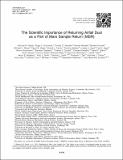The Scientific Importance of Returning Airfall Dust as a Part of Mars Sample Return (MSR)
Author(s)
Summons, Roger
DownloadPublished version (823.8Kb)
Publisher with Creative Commons License
Publisher with Creative Commons License
Creative Commons Attribution
Terms of use
Metadata
Show full item recordAbstract
Dust transported in the martian atmosphere is of intrinsic scientific interest and has relevance for the planning of human missions in the future. The MSR Campaign, as currently designed, presents an important opportunity to return serendipitous, airfall dust. The tubes containing samples collected by the Perseverance rover would be placed in cache depots on the martian surface perhaps as early as 2023-24 for recovery by a subsequent mission no earlier than 2028-29, and possibly as late as 2030-31. Thus, the sample tube surfaces could passively collect dust for multiple years. This dust is deemed to be exceptionally valuable as it would inform our knowledge and understanding of Mars' global mineralogy, surface processes, surface-atmosphere interactions, and atmospheric circulation. Preliminary calculations suggest that the total mass of such dust on a full set of tubes could be as much as 100 mg and, therefore, sufficient for many types of laboratory analyses. Two planning steps would optimize our ability to take advantage of this opportunity: (1) the dust-covered sample tubes should be loaded into the Orbiting Sample container (OS) with minimal cleaning and (2) the capability to recover this dust early in the workflow within an MSR Sample Receiving Facility (SRF) would need to be established. A further opportunity to advance dust/atmospheric science using MSR, depending upon the design of the MSR Campaign elements, may lie with direct sampling and the return of airborne dust.
Date issued
2022Department
Massachusetts Institute of Technology. Department of Earth, Atmospheric, and Planetary SciencesJournal
Astrobiology
Publisher
Mary Ann Liebert Inc
Citation
Summons, Roger. 2022. "The Scientific Importance of Returning Airfall Dust as a Part of Mars Sample Return (MSR)." Astrobiology, 22 (S1).
Version: Final published version